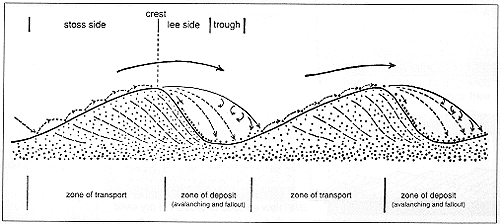

Bed forms: eolian dunes
Plate 24


Bed forms: eolian dunes
Plate 24
Tractive structures are examined from two viewpoints: external shape and internal geometry. As it was said in the introductory section, the topography of both subaerial and subaqueous portions of the Earth's surface is related to sedimentary processes. In other terms, it coincides with the morphology of depositional surfaces; this can occur at various scales (see color photos 9-13), and is particularly obvious in the case of eolian dunes. Dunes and dunelike forms are the largest subaerial structures due to fluid traction.
In planform view, dune crests are more or less sinuous. Transversal dunes (color photo 9) have crests at about 90° to the main wind direction, and derive from the coalescence and rectification of barchan dunes (color photo 11). Strongly sinuous, attached dunes seen from the ground look like waves in a stormy sea. The rear, upwind side is less inclined than the steep frontal (lee) side. The slipface of the lee side is rather smooth but a shallow relief is created by scars and grooves due to avalanching of sand grains. The sliding sand forms elongate lobes in the lower slipface. The stoss side of dunes is rippled. This difference is related to different mechanical conditions of the two surfaces (inset): the stoss side is subject to traction and friction by the wind. The sand grains are entrained until they reach the crest, then their behavior is controlled by gravity alone, because the wind loses contact with the ground beyond the crest edge, and a shadow zone (separation bubble) forms there. Shear is no longer felt on the lee side, and sand grains slide down the slipface when a critical angle is exceeded; this angle is called angle of repose, and represents an equilibrium between the pull of gravity on the slope and the internal friction of the sand which resists the movement. The internal friction, also expressed by an angle, is connected with grain shape and spatial arrangement (packing, fabric). In dry sand, this angle varies over a wide range (18°-35°); values of 40° can be exceeded when the sand is wetted by rain or dew.
The transport of sand on the stoss side of dunes, and its deposition on the lee side make the dune form migrate in the wind direction. Strictly speaking, only the back portions of dunes (and the ripples superposed on them)are tractive forms; actually, the fluid force "cooperates" with gravity in producing the whole bed form. Dunes grow from smaller relieves (sand mounds behind obstacles, foredunes, see color photo 12); the roughness they create on the ground surface and the transport of sand absorbs a lot of wind energy. The growth of vegetation tends to stop the migration of dunes and to stabilize them.
Ripples represent the same process (friction at the air-sand interface) on a smaller scale. Some differences, however, exist. For example, the grains can jump from crest to crest when saltation is the dominant mode of movement. The impact of landing grains dislodges other grains, which are then mobilized in a sort of chain reaction. Ripples created by saltation are called impact ripples, in contrast to normal ripples where the grains climb the stoss side and slide down the lee side.
Dunes and ripple represent forms of dynamic equilibrium between flow and bottom sediment; this means that they are neutral in terms of both deposition and erosion. In other words, no net deposition or erosion occur during their formation: the sediment is in transit and the interface in a steady state. Some bed forms, however, are stable even in conditions of net sedimentation (see plates 54-56).
| Photo: A. Roberts 1970. |